By Marc Sheppard, American Thinker
“New scientific discoveries are casting doubt on how much of the warming of the twentieth century was natural and how much was man-made, and governments around the world are beginning to confront the astronomical cost of reducing emissions. Economists, meanwhile, are calculating that the cost of slowing or stopping global warming exceeds the social benefits.”
So spoke Senator James Inhofe on the Senate floor on May 17th, reading into the record the mission statement of the climate conference he was scheduled to be speaking at that very moment. Rather than addressing the Monday lunch session of Heartland’s Fourth International Conference on Climate Change, the Ranking Member of the Senate Committee on Environment and Public Works remained in Washington, responding to the prior week’s Kerry-Lieberman “climate bill” proposal.
The Oklahoma Republican, who had assured attendees of last year’s ICCC on Capitol Hill that no cap-and-tax bill would ever pass the Senate, now stood before C-SPANís cameras doing what only one major news organization - Fox—had done before him: acknowledging the existence and significance of the 700-plus scientists, economists, policymakers, and concerned citizens gathering some 600 miles away in Chicago. And their collective objective to “build public awareness of the global warming ‘realism’ movement,” so that “sound science and economics, rather than exaggeration and hype” might “determine what actions, if any, are taken to address the problem of climate change.”
Had the mainstream media acted responsibly, then every word spoken at the first major post-Climategate climate colloquium would have indeed built public awareness of the implausibility of manmade global warming and, consequently, any job-killing legislation, treaties or regulations designed to “control” it. But ours is an agenda-driven MSM - brazenly toting water for a president and Hill Democrats shamelessly rolling out the Gulf-coast disaster crash-cart to reanimate their flat-lined “climate” bill.
Mine is the task of summarizing - to the best of my ability—the current state of climate reality, as espoused before me one month ago by no less than the greatest minds analyzing the subject today. And yours is the opportunity to quickly absorb the collective wisdom of over 75 experts speaking at 5 plenary and 20 breakout sessions, and countless marvelous conversations, all spread over 3 days. And to discover or affirm the myriad inconvenient truths behind the “global warming” hype.
Let’s begin with arguably the most significant but unquestionably the most conference-ubiquitous.
Currents and Current Cooling
For years now, alarmists have arrogantly ignored the cooling we’ve experienced worldwide since 1999, continuing their demands that we sacrifice everything - jobs, money, comfort, progress and ultimately, freedom—to halt fictitious “runaway global warming.” Such unfounded hysteria seems all the more inane after hearing the unvarnished truth from the experts at ICCC-4, beginning with their predictions that the global cooling will likely continue for the next few decades.
Geologist Don Easterbrook was one of many attending scientists attributing natural climate variations to solar irradiance and deep ocean currents. His ICCC-4 announced paper, The Looming Threat of Global Cooling, noted the undeniable link between the Pacific Decadal Oscillation (PDO) shifting to its warm mode in 1915 and 1977 and global warming resulting both times. Conversely, in 1945 and 1999 the PDO moved to its cool mode and the globe cooled right along, despite a rapid increase in atmospheric CO2 during the period. What’s more, climate changes in the geologic record show a regular pattern of alternate warming and cooling with a 25-30 year period for the past 500 years. Easterbrook thereby concludes that we should “expect global cooling for the next 2-3 decades that will be far more damaging than global warming would have been.”
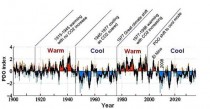
Fig. 1 - From Don Easterbrook (enlarged here). Since 1900, global temperatures have closely correlated with the PDO Index. This belies AGW and portends a coming big chill.
Easterbrook noted a strong correlation between PDO and solar activity, as did geophysicist Victor Manuel Velasco Herrara, who believes an even longer cold spell (60-80 years) has begun—triggered by a decrease in solar activity. Habibullo Abdussamatov agrees, and illustrated how the 18 Little Ice Ages that occurred in the past 7500 years can all be attributed to “natural bicentennial variations in the average annual values of the total solar irradiance (TSI)” and its secondary subsequent feedback effects (natural changes in the albedo, water vapor abundance, etc.). Abdussamatov demonstrated that each time the TSI reached a peak (up to 0.2%) a period of global warming began “with a time lag of 15 plus or minus 6 years defined by the thermal inertia of the Ocean (despite the absence of anthropogenic influence).” Contrarily, “each deep bicentennial descent in the TSI caused a Little Ice Age.” Based on the present cycle, the astrophysicist expects “the beginning of the new Little Ice Age epoch approximately in 2014.”
Hurricane specialist William Gray also brought along some mighty convincing charts proving that most of the warming experienced in the past thousand years can be attributed to deep ocean circulations, strengthened and weakened by century-scale salinity variations. While the relationship of Sea Surface Temperatures to evaporation, rainfall and wind patterns, albedo and, ultimately, air temperature is complex and beyond the scope of this article, suffice it to say that this translates to ocean - not carbon—driven global temperatures.
Gray believes the Medieval Warm Period (MWP) was a result of a multi-century slowdown of the Meridional Overturning Circulation (MOC), similar to that experienced in the 20th century and corresponded to similar warming. Conversely, the Little Ice Age (LIA) was a period of stronger than average MOC, as we are beginning to see today. Gray, too, predicts that strengthening ocean currents portend global cooling over the next few decades, even as carbon dioxide levels continue to climb.
So how is it that the National Oceanic and Atmospheric Administration’s (NOAA) National Climatic Data Center just declared this year’s January-May period the warmest on record?
“If we torture the data long enough, it will confess”
AT readers are no doubt well aware that, thanks in large part to the efforts of WUWT’s indefatigable Anthony Watts, weíve known for years that over 90% of American stations misreport temperature data by between 1C and 5C. Furthermore, “smoothing” adjustments to “homogenize” station data to that of surrounding stations and dismissal of the biasing phenomenon known as the Urban Heat Island Effect have grossly exaggerated 20th-century warming.
Not coincidentally, Dr. Craig Loehle concluded that after subtracting UHIE and other measurement artifacts, a 59 year natural cycle of warming and cooling remains. And while that cycle matches that of the PDO to a tee, the MSM respond as though only “deniers” could possibly suggest a link.
But last November we learned just how far ideologues at England’s Climate Research Unit were willing to go when glaring evidence that its scientists had doctored climate data to remove previous warm periods from the history books while exaggerating modern warming and suppressing modern cooling surfaced (enlarged here).

And that’s just the beginning. As Joe D’Aleo explained, “homogenization and other adjustments blend the good with the bad, usually cooling off early warm periods, producing a warming where none existed.” For instance, NOAA removed UHIE adjustments from US Data in 2007, which “changed a cooling trend since 1940 to a warming trend.”
This section’s heading is a quote from Ronald Coase, fittingly cited by D’Aleo during his presentation. For more details on why Joe concludes that “the surface data and models should not have been used for decision making by the EPA or the congress,” and that any proclamations of “warmest months,” “warmest years,” or “warmest” anything are utterly meaningless. Of course, the instrumental data manipulated by the US agencies is accepted as gospel by climate agencies worldwide.
Read much more here.
NOTE: Heartland has the presentations and powerpoints posted for the Heartland ICCC IV. If you could not go, there is plenty to see there.
By Stuart Clark
SUNSPOTS come and go, but recently they have mostly gone. For centuries, astronomers have recorded when these dark blemishes on the solar surface emerge, only for them to fade away again after a few days, weeks or months. Thanks to their efforts, we know that sunspot numbers ebb and flow in cycles lasting about 11 years.

But for the past two years, the sunspots have mostly been missing. Their absence, the most prolonged for nearly a hundred years, has taken even seasoned sun watchers by surprise. “This is solar behaviour we haven’t seen in living memory,” says David Hathaway, a physicist at NASA’s Marshall Space Flight Center in Huntsville, Alabama.
The sun is under scrutiny as never before thanks to an armada of space telescopes. The results they beam back are portraying our nearest star, and its influence on Earth, in a new light. Sunspots and other clues indicate that the sun’s magnetic activity is diminishing, and that the sun may even be shrinking. Together the results hint that something profound is happening inside the sun. The big question is what?
The stakes have never been higher. Groups of sunspots forewarn of gigantic solar storms that can unleash a billion times more energy than an atomic bomb. Fears that these giant solar eruptions could create havoc on Earth, and disputes over the sun’s role in climate change, are adding urgency to these studies. When NASA and the European Space Agency launched the Solar and Heliospheric Observatory almost 15 years ago, “understanding the solar cycle was not one of its scientific objectives”, says Bernhard Fleck, the mission’s project scientist. “Now it is one of the key questions.”
Sun behaving badly
Sunspots are windows into the sun’s magnetic soul. They form where giant loops of magnetism, generated deep inside the sun, well up and burst through the surface, leading to a localised drop in temperature which we see as a dark patch. Any changes in sunspot numbers reflect changes inside the sun. “During this transition, the sun is giving us a real glimpse into its interior,” says Hathaway.
When sunspot numbers drop at the end of each 11-year cycle, solar storms die down and all becomes much calmer. This “solar minimum” doesn’t last long. Within a year, the spots and storms begin to build towards a new crescendo, the next solar maximum.
What’s special about this latest dip is that the sun is having trouble starting the next solar cycle. The sun began to calm down in late 2007, so no one expected many sunspots in 2008. But computer models predicted that when the spots did return, they would do so in force. Hathaway was reported as thinking the next solar cycle would be a “doozy”: more sunspots, more solar storms and more energy blasted into space. Others predicted that it would be the most active solar cycle on record. The trouble was, no one told the sun.
The latest solar cycle was supposed to be the most active on record. The trouble was, no one told the sun. The first sign that the prediction was wrong came when 2008 turned out to be even calmer than expected. That year, the sun was spot-free 73 per cent of the time, an extreme dip even for a solar minimum. Only the minimum of 1913 was more pronounced, with 85 per cent of that year clear.
As 2009 arrived, solar physicists looked for some action. They didn’t get it. The sun continued to languish until mid-December, when the largest group of sunspots to emerge for several years appeared. Finally, a return to normal? Not really.
Even with the solar cycle finally under way again, the number of sunspots has so far been well below expectations. Something appears to have changed inside the sun, something the models did not predict. But what?
The flood of observations from space and ground-based telescopes suggests that the answer lies in the behaviour of two vast conveyor belts of gas that endlessly cycle material and magnetism through the sun’s interior and out across the surface. On average it takes 40 years for the conveyor belts to complete a circuit (see diagram).
When Hathaway’s team looked over the observations to find out where their models had gone wrong, they noticed that the conveyor-belt flows of gas across the sun’s surface have been speeding up since 2004.
The circulation deep within the sun tells a different story. Rachel Howe and Frank Hill of the National Solar Observatory in Tucson, Arizona, have used observations of surface disturbances, caused by the solar equivalent of seismic waves, to infer what conditions are like within the sun. Analysing data from 2009, they found that while the surface flows had sped up, the internal ones had slowed to a crawl.
These findings have thrown our best computer models of the sun into disarray. “It is certainly challenging our theories,” says Hathaway, “but that’s kinda nice.”
It is not just our understanding of the sun that stands to benefit from this work. The extent to which changes in the sun’s activity can affect our climate is of paramount concern. It is also highly controversial. There are those who seek to prove that the solar variability is the major cause of climate change, an idea that would let humans and their greenhouse gases off the hook. Others are equally evangelical in their assertions that the sun plays only a minuscule role in climate change.
If this dispute could be resolved by an experiment, the obvious strategy would be to see what happens when you switch off one potential cause of climate change and leave the other alone. The extended collapse in solar activity these past two years may be precisely the right sort of test, in that it has significantly changed the amount of solar radiation bombarding our planet. “As a natural experiment, this is the very best thing to happen,” says Joanna Haigh, a climatologist at Imperial College London. “Now we have to see how the Earth responds.”
The climate link
Mike Lockwood at the University of Reading, UK, may already have identified one response - the unusually frigid European winter of 2009/10. He has studied records covering data stretching back to 1650, and found that severe European winters are much more likely during periods of low solar activity (New Scientist, 17 April, p 6). This fits an emerging picture of solar activity giving rise to a small change in the global climate overall, yet large regional effects.
Another example is the Maunder minimum, the period from 1645 to 1715 during which sunspots virtually disappeared and solar activity plummeted. If a similar spell of solar inactivity were to begin now and continue until 2100, it would mitigate any temperature rise through global warming by 0.3 C on average, according to calculations by Georg Feulner and Stefan Rahmstorf of the Potsdam Institute for Climate Impact Research in Germany. However, something amplified the impact of the Maunder minimum on northern Europe, ushering in a period known as the Little Ice Age, when colder than average winters became more prevalent and the average temperature in Europe appeared to drop by between 1 and 2 C.
A corresponding boost appears to be associated with peaks in solar output. In 2008, Judith Lean of the Naval Research Laboratory in Washington DC published a study showing that high solar activity has a disproportionate warming influence on northern Europe (Geophysical Research Letters, vol 35, p L18701).
So why does solar activity have these effects? Modellers may already be onto the answer. Since 2003, spaceborne instruments have been measuring the intensity of the sun’s output at various wavelengths and looking for correlations with solar activity. The results point to the sun’s emissions of ultraviolet light. “The ultraviolet is varying much, much, much more than we expected,” says Lockwood.
Ultraviolet light is strongly linked to solar activity: solar flares shine brightly in the ultraviolet, and it helps carry the explosive energy of the flares away into space. It could be particularly significant for the Earth’s climate as ultraviolet light is absorbed by the ozone layer in the stratosphere, the region of atmosphere that sits directly above the weather-bearing troposphere.
More ultraviolet light reaching the stratosphere means more ozone is formed. And more ozone leads to the stratosphere absorbing more ultraviolet light. So in times of heightened solar activity, the stratosphere heats up and this influences the winds in that layer. “The heat input into the stratosphere is much more variable than we thought,” says Lockwood.
Enhanced heating of the stratosphere could be behind the heightened effects felt by Europe of changes in solar activity. Back in 1996, Haigh showed that the temperature of the stratosphere influences the passage of the jet stream, the high-altitude river of air passing from west to east across Europe.
Lockwood’s latest study shows that when solar activity is low, the jet stream becomes liable to break up into giant meanders that block warm westerly winds from reaching Europe, allowing Arctic winds from Siberia to dominate Europe’s weather.
The lesson for climate research is clear. “There are so many weather stations in Europe that, if we are not careful, these solar effects could influence our global averages,” says Lockwood. In other words, our understanding of global climate change could be skewed by not taking into account solar effects on European weather.
Just as one mystery begins to clear, another beckons. Since its launch 15 years ago, the SOHO spacecraft has watched two solar minimums, one complete solar cycle, and parts of two other cycles - the one that ended in 1996 and the one that is just stirring. For all that time its VIRGO instrument has been measuring the total solar irradiance (TSI), the energy emitted by the sun. Its measurements can be stitched together with results from earlier missions to provide a 30-year record of the sun’s energy output. What this shows is that during the latest solar minimum, the sun’s output was 0.015 per cent lower than during the previous lull. It might not sound like much, but it is a hugely significant result.
We used to think that the sun’s output was unwavering. That view began to change following the launch in 1980 of NASA’s Solar Maximum Mission. Its observations show that the amount of energy the sun puts out varies by around 0.1 per cent over a period of days or weeks over a solar cycle. See rest of story here. Here is a recent ICECAP story on the ultraviolet role in climate.
By Joe Dejka
Millard Public Schools will stop using a children’s book about global warming—but only until the district can obtain copies with a factual error corrected.
A review committee, convened after parents complained, concluded that author Laurie David’s book, “The Down-to-Earth Guide to Global Warming,” contained “a major factual error” in a graphic about rising temperatures and carbon dioxide levels.
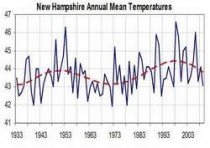
Mark Feldhausen, associate superintendent for educational services, this week sent a letter to parents who complained, including the wife of U.S. Rep. Lee Terry of Nebraska, outlining the committee’s findings.
“Although the authors have pledged to correct the graph in subsequent editions, the committee recommends that this correction be made to all MPS-owned texts before using it with students in the future,” Feldhausen wrote.
Corrected versions will continue to be used in Millard’s sixth-grade language arts curriculum, he wrote.
However, the district will cease to use a companion video about global warming, narrated by actor Leonardo DiCaprio, he wrote.
The committee found the video “without merit” and recommended that it not be used.
Robyn Terry, the congressman’s wife, had described the video as a “political commercial.”
Lee and Robyn Terry released a statement saying they were pleased with the decision and “impressed” by the district’s handling of the case.
“We are pleased with their decision not to use the politically natured global warming video as a classroom instruction tool and that they have set a standard that information-based texts must be factually correct to be put in front of our children,” they wrote.
A committee of five middle school parents, three teachers and one administrator met to determine whether the book and video served a proper purpose within the curriculum.
The book, new to the Millard curriculum this year, was part of “Plugged in to Non-Fiction,” a collection of books on a variety of subjects. Parts of the book were required reading for sixth-graders in Millard reading and language-arts classes.
Three parents, including Robyn Terry, complained to the district. The Terrys’ 12-year-old son attended Beadle Middle School last year. Mrs. Terry said that the materials used in his class portrayed global warming as fact when scientists disagree.
In the video, DiCaprio attributes global warming to mankind’s “destructive addiction” to oil. He says “big corporations” and politicians gained too much money and power “on our addiction,” making them “dangerously resistant to change.”
In the letter to parents, Feldhausen said the committee recognized there are “multiple viewpoints” on global warming. The committee recommended that all teachers using the book “make students aware of both sides of the global warming theory,” he said. See story here.
SPPI was on this story nearly three years ago. We notified the publisher of the error. It was admitted to, and we were told it would be corrected. Still waiting.
After reading the SPPI post on the issue, a Mr. Dodd also notified Scholastic Books, the publisher. This was part of the email reply:
In a message dated 9/20/2007 4:06:58 AM Pacific Daylight Time,
LSchenker@Scholastic.com writes:
“Dear Mr. Dodd,
“Thank you for your email. It has been forwarded to my attention and we’re pleased to respond to your concern. It has come to our attention that a chart on page 18 of The Down-to-Earth Guide to Global Warming by Laurie David and Cambria Gordon (Orchard Books) was inadvertently mislabeled during production. We take very seriously the accuracy and vetting of all books published by Scholastic and will correct the label adjacent to the illustration showing the relationship between climate temperature and CO2 concentration in the atmosphere in subsequent printings.”
Laurie David producr of Al Gore’s Inconvenient Truth recently denied rumors of an affair with Al Gore allegedly behind the Gore’s announced divorce. Al Gore’s movie with a court found major errors and Lord Monckton’s 35 errors or exaggerations should suffer the same fate as David’s book.
By Tom Zeller Jr., New York Times
In addition to the fishermen and hoteliers whose livelihoods have been devastated by BP’s hemorrhaging undersea oil well, another group of Gulf Coast residents is beginning to suffer: the tens of thousands of workers like Ronald Brown who run the equipment or serve in support roles on deepwater oil rigs in the Gulf of Mexico.
Mr. Brown, known as Rusty to his friends, is a “shakerhand.” In the rugged vernacular of offshore drilling, that means he monitors the mud flowing back from the drill hole thousands of feet below. He works aboard the Ocean Monarch, which was idled along with 32 other oil rigs when the Obama administration ordered a six-month moratorium on all deepwater drilling after the April 20 Deepwater Horizon disaster. The rig’s owner is now seeking customers in other parts of the world. If the rig moves, Mr. Brown and his fellow motormen, roughnecks and roustabouts will be left behind, jobless, with few alternatives that would pay anything close to the $3,500 to $4,000 a month typical for such jobs.
On Wednesday, President Obama and BP announced that the company had voluntarily agreed to create a $100 million fund to compensate such rig workers. Thatís a modest sum, critics say, given the potential economic losses. Each rig job supports roughly four additional jobs for cooks, supply-ship operators and others servicing the industry. Together, they represent total monthly wages of at least $165 million, according to estimates by a Louisiana oil industry group.
Still, Mr. Brown is grateful for any assistance. “Every little bit is going to help until we figure out where else to go,” he said. “But I’m not looking forward to unemployment, and I don’t know how quickly we’ll be able to get some of it.” In an address to the nation Tuesday night, Mr. Obama apologized for the effect on oil workers who had nothing to do with the BP accident. “I know this creates difficulty for the people who work on these rigs,” he said. “But for the sake of their safety, and for the sake of the entire region, we need to know the facts before we allow deepwater drilling to continue.”
The full economic impact of the drilling moratorium is still unclear, since many of the layoffs are just beginning and no one knows how long the ban will last.
The Louisiana Mid-Continent Oil and Gas Association has warned that many of the affected rigs will seek to drill in other countries, imperiling roughly 800 to 1,400 jobs per rig, including third-party support personnel. The securities firm Raymond James and Associates predicts that the moratorium could last well into 2011, directly jeopardizing 50,000 jobs and potentially gutting blue-collar communities that rely heavily on the economic activity that comes with deepwater work. “Just as the demise of auto plants and steel mills in the Upper Midwest devastated entire towns, an extended drilling ban could eventually have a similar effect in the Gulf Coast,” the company said in a report Monday.
Lawrence R. Dickerson, the chief executive of Diamond Offshore Drilling, which owns the Ocean Monarch and five other deepwater rigs in the gulf, was less pessimistic, suggesting that 15,000 to 20,000 rig and associated service jobs were at risk. He predicted that some deepwater rigs would remain in the area awaiting a resumption of drilling, but that all would be forced to cut staff as the moratorium continued.
Three Diamond rigs are already prospecting for jobs in the Mediterranean and West Africa. Should they leave, they would take less than half of their crew with them, Mr. Dickerson said. The halt in drilling in waters deeper than 500 feet came in response to the still-unchecked gusher of oil that followed the Deepwater Horizon explosion, which killed 11 workers. The goal was to give the government time to review the rules and oversight of such wells, and the shutdown was welcomed by many Americans who have watched the environmental disaster unfold.
But like fishing and tourism, deepwater drilling is also crucial to the Gulf economy. At a Congressional hearing last week, Senator Mary Landrieu, a Democrat from Louisiana, confronted Interior Secretary Ken Salazar with a list of local companies that serviced and depended on offshore energy development. She said that a temporary drill ban, even if it only lasted a few months, could affect as many as 330,000 people in Louisiana alone. That would “potentially wreak economic havoc on this region that exceeds the havoc wreaked by the spill itself,” she said.
Until two weeks ago, the Ocean Monarch - a mammoth, $300 million semi-submersible not unlike the Deepwater Horizon owned by Transocean - was poised to drill a well in 4,000 feet of water at a spot more than 100 miles offshore. About 115 workers from a variety of companies were onboard. After the moratorium, Cobalt International Energy, the company that had hired the Monarch and spent $60 million preparing to drill the well, said it was looking to dissolve the contract.
Those negotiations continue, but when two New York Times reporters visited the rig last week, it was squatting in just 50 feet of water 27 miles off the coast of Louisiana. On the deck, 75-foot segments of riser pipe were stacked in tidy rows two stories high, and the rig’s manifest listed just 77 crew members aboard. At a meeting with the crew, Mr. Dickerson talked about the uncertain future. “You know, if we can’t go back to work for a minimum six months or longer, it’s awfully hard to leave rigs sitting here,” he said.
Once a rig moves, it tends to stay put, fulfilling multiyear contracts. Lower-level jobs are normally filled using the host country’s work force. After the meeting with Mr. Dickerson, a handful of rig workers - burly men in oil-stained T-shirts and overalls - shared their gnawing fear that the jobs that paid their modest mortgages, doctor bills and children’s tuitions were about to disappear.
Louis Alvarez, a motorman and 21-year veteran with Diamond Offshore, said that a layoff could hinder plans that he and his wife had made to send their son to college in the fall. “It’s a shame that I have to tell my 18-year-old son that he might have to help his daddy buy groceries,” he said. Mr. Brown, the shakerhand, began to cry when he said that his wife, Athena, was now looking for a job.
A broad-shouldered, broad-faced man, Mr. Brown, 29, is paid roughly $22 an hour to work the rig’s standard two-week-on, two-week-off cycle, supplemented by occasional overtime. That’s enough to support Athena and their three children: 5-year-old Shiloh, 3-year-old Maelah, and 1-year-old Bennett, who wears a brace to help correct club feet.
The job prospects around their home in Magee, Miss., a dilapidated town of about 4,000, are few. Tyson Foods and Polk’s Meat Products have plants in the area, but would be unlikely to match a rig worker’s paycheck. In an interview at their home, Mrs. Brown said that someday, the country might find a low-cost alternative to oil. “But we don’t have an option right now,” she said. “For us to stop drilling in the gulf is like ending our lives as far as the way we live. It’s really that scary.” See post here.
By Tom Zeller Jr., New York Times
In addition to the fishermen and hoteliers whose livelihoods have been devastated by BP’s hemorrhaging undersea oil well, another group of Gulf Coast residents is beginning to suffer: the tens of thousands of workers like Ronald Brown who run the equipment or serve in support roles on deepwater oil rigs in the Gulf of Mexico.
Mr. Brown, known as Rusty to his friends, is a “shakerhand.” In the rugged vernacular of offshore drilling, that means he monitors the mud flowing back from the drill hole thousands of feet below. He works aboard the Ocean Monarch, which was idled along with 32 other oil rigs when the Obama administration ordered a six-month moratorium on all deepwater drilling after the April 20 Deepwater Horizon disaster. The rig’s owner is now seeking customers in other parts of the world. If the rig moves, Mr. Brown and his fellow motormen, roughnecks and roustabouts will be left behind, jobless, with few alternatives that would pay anything close to the $3,500 to $4,000 a month typical for such jobs.
On Wednesday, President Obama and BP announced that the company had voluntarily agreed to create a $100 million fund to compensate such rig workers. Thatís a modest sum, critics say, given the potential economic losses. Each rig job supports roughly four additional jobs for cooks, supply-ship operators and others servicing the industry. Together, they represent total monthly wages of at least $165 million, according to estimates by a Louisiana oil industry group.
Still, Mr. Brown is grateful for any assistance. “Every little bit is going to help until we figure out where else to go,” he said. “But I’m not looking forward to unemployment, and I don’t know how quickly we’ll be able to get some of it.” In an address to the nation Tuesday night, Mr. Obama apologized for the effect on oil workers who had nothing to do with the BP accident. “I know this creates difficulty for the people who work on these rigs,” he said. “But for the sake of their safety, and for the sake of the entire region, we need to know the facts before we allow deepwater drilling to continue.”
The full economic impact of the drilling moratorium is still unclear, since many of the layoffs are just beginning and no one knows how long the ban will last.
The Louisiana Mid-Continent Oil and Gas Association has warned that many of the affected rigs will seek to drill in other countries, imperiling roughly 800 to 1,400 jobs per rig, including third-party support personnel. The securities firm Raymond James and Associates predicts that the moratorium could last well into 2011, directly jeopardizing 50,000 jobs and potentially gutting blue-collar communities that rely heavily on the economic activity that comes with deepwater work. “Just as the demise of auto plants and steel mills in the Upper Midwest devastated entire towns, an extended drilling ban could eventually have a similar effect in the Gulf Coast,” the company said in a report Monday.
Lawrence R. Dickerson, the chief executive of Diamond Offshore Drilling, which owns the Ocean Monarch and five other deepwater rigs in the gulf, was less pessimistic, suggesting that 15,000 to 20,000 rig and associated service jobs were at risk. He predicted that some deepwater rigs would remain in the area awaiting a resumption of drilling, but that all would be forced to cut staff as the moratorium continued.
Three Diamond rigs are already prospecting for jobs in the Mediterranean and West Africa. Should they leave, they would take less than half of their crew with them, Mr. Dickerson said. The halt in drilling in waters deeper than 500 feet came in response to the still-unchecked gusher of oil that followed the Deepwater Horizon explosion, which killed 11 workers. The goal was to give the government time to review the rules and oversight of such wells, and the shutdown was welcomed by many Americans who have watched the environmental disaster unfold.
But like fishing and tourism, deepwater drilling is also crucial to the Gulf economy. At a Congressional hearing last week, Senator Mary Landrieu, a Democrat from Louisiana, confronted Interior Secretary Ken Salazar with a list of local companies that serviced and depended on offshore energy development. She said that a temporary drill ban, even if it only lasted a few months, could affect as many as 330,000 people in Louisiana alone. That would “potentially wreak economic havoc on this region that exceeds the havoc wreaked by the spill itself,” she said.
Until two weeks ago, the Ocean Monarch - a mammoth, $300 million semi-submersible not unlike the Deepwater Horizon owned by Transocean - was poised to drill a well in 4,000 feet of water at a spot more than 100 miles offshore. About 115 workers from a variety of companies were onboard. After the moratorium, Cobalt International Energy, the company that had hired the Monarch and spent $60 million preparing to drill the well, said it was looking to dissolve the contract.
Those negotiations continue, but when two New York Times reporters visited the rig last week, it was squatting in just 50 feet of water 27 miles off the coast of Louisiana. On the deck, 75-foot segments of riser pipe were stacked in tidy rows two stories high, and the rig’s manifest listed just 77 crew members aboard. At a meeting with the crew, Mr. Dickerson talked about the uncertain future. “You know, if we canít go back to work for a minimum six months or longer, it’s awfully hard to leave rigs sitting here,” he said.
Once a rig moves, it tends to stay put, fulfilling multiyear contracts. Lower-level jobs are normally filled using the host country’s work force. After the meeting with Mr. Dickerson, a handful of rig workers - burly men in oil-stained T-shirts and overalls - shared their gnawing fear that the jobs that paid their modest mortgages, doctor bills and children’s tuitions were about to disappear.
Louis Alvarez, a motorman and 21-year veteran with Diamond Offshore, said that a layoff could hinder plans that he and his wife had made to send their son to college in the fall. “It’s a shame that I have to tell my 18-year-old son that he might have to help his daddy buy groceries,” he said. Mr. Brown, the shakerhand, began to cry when he said that his wife, Athena, was now looking for a job.
A broad-shouldered, broad-faced man, Mr. Brown, 29, is paid roughly $22 an hour to work the rig’s standard two-week-on, two-week-off cycle, supplemented by occasional overtime. That’s enough to support Athena and their three children: 5-year-old Shiloh, 3-year-old Maelah, and 1-year-old Bennett, who wears a brace to help correct club feet.
The job prospects around their home in Magee, Miss., a dilapidated town of about 4,000, are few. Tyson Foods and Polk’s Meat Products have plants in the area, but would be unlikely to match a rig worker’s paycheck. In an interview at their home, Mrs. Brown said that someday, the country might find a low-cost alternative to oil. “But we don’t have an option right now,” she said. “For us to stop drilling in the gulf is like ending our lives as far as the way we live. It’s really that scary.” See post here.
By Peter Foster
Why would scientists allow themselves to be recruited to essentially political objectives?
The past six months has seen a series of unprecedented setbacks for the cause of catastrophic man-made climate change: the collapse of the Kyoto process; the release of incriminating Climategate emails; the discovery of the shoddy standards of the Intergovernmental Panel on Climate Change (IPCC); the mounting evidence that a job-creating green industrial revolution is a fantasy; and the growing suspicion by the public that it has been sold a bill of goods.
The British Royal Society recently released a statement that “Any public perception that the science is somehow fully settled is wholly incorrect,” thus contradicting its own former president, and true believer, Lord May. And if the science isn’t settled, there can hardly ever have been “consensus” on the issue.
A forthcoming paper by Mike Hulme, Professor of Climate Change at the University of East Anglia, from which the Climategate emails emerged, admits that the actual group involved in the “consensus” that “human activities are having a significant influence on the climate” was in fact “only a few dozen,” rather than the thousands invoked by the IPCC.
Last week, economist Richard Tol, one of the IPCC’s own lead authors, suggested that the whole IPCC process should be suspended until the selection of authors has been fixed. This week, the IPCC’s head, Rajendra Pachauri, who has previously accused skeptics of flat Earthism and “voodoo science,” suddenly had a Damascene conversion as to the validity of dissent. “I am not deaf,” he wrote, “to those who do not agree with the scientific consensus on man-made climate change. Nor, indeed, to those who do not agree with the findings - or, in some cases, the existence - of the IPCC.”
But while such newfound humility (even though still embracing bogus “consensus") is welcome, every country on Earth is still officially committed to catastrophic man-made warming as a reality that demands a draconian policy response. The erection of such a massive commitment on such shaky foundations begs for explanation, and must be put in both a larger political and psychological context.
Hubristic overestimation of human significance - in this case both for doing harm and correcting it by policy - may be the fundamental reason for broad acceptance of man-made climate change theory. The notion that manís sinful and selfish ways will be punished goes back to the myth of the Flood. In many ways, belief in climate apocalypse reflects similar moralistic disapproval of “materialist” Western society, and the claim that its wealth has been bought at the expense of others, including now that of “future generations.”
This quasi-religious belief is particularly appealing to the political and bureaucratic classes, because it provides new justifications for intervention to correct the imperfections and ongoing inequities of perpetually demonized capitalism. In a classic example of psychological “projection,” however, alarmists claim that it is their opponents who are tainted by “greed” and “self-interest.”
One insufficiently addressed question is why scientists would allow themselves to be recruited to essentially political objectives. Another is why they seem so resolutely committed to increasingly shaky theories, and lash out at critics. Surveys have shown that natural scientists tend to be left-liberal in their leanings. Many perhaps believe that a world with more top-down economic control and greater transfers to poor nations is desirable whatever the realities of climate science, and that given the possibility (however remote) of man-made climate catastrophe, that it is appropriate to adopt the “precautionary principle.”
Such a mindset can be buttressed by the way science is done. In his classic book The Structure of Scientific Revolutions, Thomas Kuhn noted that scientific groups adopted, and committed to, “paradigms,” which then became fundamentally unquestionable. That stance was hardened further when moral values, such as being “socially useful,” were involved.
The IPCC came with its moralistic paradigms pre-installed.
Kuhn noted that “professionalization” of any paradigm leads to “an immense restriction of the scientistís vision and to a considerable resistance to paradigm change.” He even suggested that a scientist, as a captive to a paradigm, is “like the typical character of Orwell’s 1984, the victim of a history rewritten by the powers that be.”
Kuhn also suggested why catastrophic man-made climate change theory - even if it is found to have been greatly exaggerated, or even falsified - will take a good deal of killing. “The transfer of allegiance from paradigm to paradigm,” he wrote, “is a conversion experience that cannot be forced.” The problem is that there is no other clear and simple climate theory to which to be “converted” at the moment.
Kuhn noted that the Earth-centred Ptolemaic system of astronomy, based on elaborately waltzing planets, “worked” for a long time, but eventually became a monster whose complications overwhelmed its usefulness. Then along came Copernicus. The resultant destruction of the Earth-centred universe led to enormous soul-searching, as did Darwin’s vaporizing of the assumption of biological “progress” towards divine ends.
For most modern liberals, including many scientists, the market sun still goes round the government Earth, and it’s a paradigm they are reluctant to change. Policy skeptics, by contrast, who are still trying to establish the revolutionary and counterintuitive insights of Adam Smith, point out that carbon rationing, green industrial strategy and aid transfers under the aegis of “clean development” are - whatever the science - economic junk. Read more here. H/T Benny Peiser, CCNet.
See also this earlier post here.
By Richard Fernandez
The northern summer months mean winter in the Antipodes so we drove to Anthony Watts’ presentation in the dark even though it was only 6 pm. He was the principal author of Watts Up With That?, a climate change skeptic’s blogsite that gets about 3 million hits per month. And now he was in Australia on a speaking tour. The site has a large following in Australia probably due to two things. The first is his symbiotic relationship with the Herald Sun’s Andrew Bolt, who is Australia’s blogger/mainstream journalist - a combination you don’t often see - who appears to combine the strongest features of both and who quotes Watts continuously and extensively so that climate skepticism has become as it were, the new occult knowledge. Second, Watts’ focus on the weather taps into a major preoccupation in Australia: crops.
As a consequence there is, one may be surprised to learn, a Climate Skeptics Party in Australia and a huge appetite for knowing Watts Up With That. Climate change is a much bigger political issue in Australia than in the USA. The audience filed into the auditorium with a near-religious reverence for Watts. He was preceded by two speakers, one an economist and the other an expert on the effect of solar cycles on climate. The first argued that CO2 was undervalued and the second explained the effects of sunspots on cloud formation. But it was Watts presentation that stole the show. Why?
Not for any superiority in presentation. What distinguished it from theirs was that Watts talk wasn’t really about a logical argument. It was about how to create a logical argument of sufficient authority to challenge the establishment. He was describing an open source research project, though perhaps much of the audience failed to realize it. Watts reeled them in as good speakers do, by telling them a story. He described how he had originally been a Global Warmist who had experienced a Pauline conversion on the most innocent of grounds. He had fascinated by measuring instruments and gadgetry and always had been. After retiring from a career as a TV weatherman he began to wonder whether a change in the specification of the paint used to coat temperature measuring stations might have anything to do with the rise in recorded readings. It was a simple enough idea. When temperatures were first collected the temp stations consisted of a whitewashed birdhouse like structure with a mercury thermometer in it. As recently as the 60s the whitewash was still used to maintain a consistency in experimental apparatus. And then the weather service changed the spec to paint. So he asked: Watts Up With That?
Watts bought a bunch of standard measuring stations and coated one with whitewash and the other with the newly specified paint and found the painted stations gave higher readings than the stations finished in the older calcium carbonate. This disturbed him but as way led on to way it brought him face to face with another discovery. Most of the temperature stations had been sited, for ease of reading, right next to buildings else urban sprawl had overtaken them so that stations formerly standing in a field were now in the middle of parking lots, sewage plants, airports and heat sinks of a similar nature. Watts was now confronted with the possibility that his whole belief structure was wrong because the data on which it was established was erroneous. Somewhere along the line a light bulb went on his brain and the fun began.
My guess is that the former weatherman understood something that neither of two pure academicians who preceded him fully grasped. If he was going to challenge the established storyline he was going to need power. Where did it come from? Power comes from owning information; second power comes from being able to gather info that nobody else can. So he began an open source project to study as many temperature recording sites as he could. Wattsí biggest asset was not his scientific background but an organizational/businessman’s ability and the media practicioner’s understanding of how to use publicity. In this instance he decided to use his blog to solicit volunteer data gathering. The result was SurfaceStations.Org.
In 2007 Watts launched the “SurfaceStations.org” project, whose mission is to create a publicly available database of photographs of weather stations, along with their metadata, in response to what he described as “a massive failure of bureaucracy to perform something so simple as taking some photographs and making some measurements and notes of a few to a few dozen weather stations in each state”. The project relies on volunteers to gather the data.[8] The method used is to attract volunteers of varying levels of expertise who undertake to estimate the siting, usage and other conditions of weather stations in NOAA’s Historical Climatology Network (USHCN) and grade them for their compliance with the standards published in the organization’s Climate Reference Network Site Handbook.
Soon after launching the project, when 40 or so of the 1221 USHCN climatological surface temperature monitoring stations had been surveyed, Watts stated that his preliminary findings raised doubts about NOAA’s temperature reporting. “I believe,” he said, “we will be able to demonstrate that some of the global warming increase is not from CO2 but from localized changes in the temperature-measurement environment.” By 2009, the project had documented over 860 stations using over 650 volunteers. In a report entitled Is the U.S. Surface Temperature Record Reliable?, published by the Heartland Institute, Watts concludes that “the errors in the [U.S. temperature] record exceed by a wide margin the purported rise in temperature...during the twentieth century.”
Watts’ presentation at the hall consisted of seemingly unending stream of slides from his volunteers showing not just US, but foreign weather stations sited in the most laughable of ways: in the path of jet exhaust, air conditioning heat dumps, fermenting sewage plants, concrete heat sinks, in close proximity to machinery, motors, engines, incinerators and even atop tombstones. He then proceeded to flash a series of infrared images of the same sites showing the surrounds of the temperature stations all lit up. Then he piled Google Earth image upon Google Earth image of the temperature collection sites in winter showing the snow stretching far and away but for the little islands of heat in which the gauges were located.
It was a tour de force. He understood the power of irrefutable reptition. Following the old rule of “tell them what you’re going to tell them, tell them and tell them what you told them”, Watts pitched his message to the denominator everyone could grasp. He had a weatherman’s instinct for making a complex subject concrete and in your face. But he could do this only because he had mobilized a legion of part time snoops, guys who would drive out to airports near them, walk around universities to snap photos of temperature stations, go down some dirt road to find an obscure little measuring device or spends hours on Google Earth zooming in on a known coordinate. He could do this because he had a dataset - a dataset not even the weather service had. His open source project gave him more information about the condition of their terrestrial network than the weather service had. He had power and they knew it. What happened next was extraordinary but entirely predictable. The bureaucracy fought back. The weather service pre-emptively used his data, over his objections they were incomplete, to refute him.
On July 6, 2009 the National Oceanic and Atmospheric Administration issued a preliminary report that charted data from 70 stations that SurfaceStations.org identified as ‘good’ or ‘best’ against the rest of the dataset surveyed at that time, and concluded, “clearly there is no indication from this analysis that poor station exposure has imparted a bias in the U.S. temperature trends.” Watts issued a rebuttal in which he asserted that the preliminary analysis excluded new data on quality of surface stations, and criticized the use of homogenized data from the stations, which in his view accounts for the creation of two nearly identical graphs. Since then NOAA has released a detailed peer reviewed study confirming both reliability of the surface stations reviewed. The results show that poor stations produce a slight cooling bias, in stark contrast to Watts claim, but also that after corrections both poor and highly rated stations align very well.
If imitation is the sincerest form of flattery it was an extraordinary compliment to Anthony Watts. But they took it too soon or maybe he objected to their use of his incomplete data because he understood the more he objected the more precipitately they would insert their heads into the noose. The data gathered by his volunteers was only just ramping up and now he has much more data - most of which will not only undermine the NOAA study based on his partial data set - but put the case for data corruption more strongly. The problem Anthony Watts now faces is getting a journal to publish his stuff. But even here the savvy weatherman may know that legitimacy can be acquired in two way. The first is if a prestigious journal publishes his study and the second is if they refuse to publish his study. Although Watts’ scientific claims are interesting on their own, it was the way in which he used the Internet, employed the media, created an open source project that really fascinated me. This was a Harvard Business/Kennedy School case study if ever there was one.
I shook his hand after the lecture and then we popped out into a winter night that was colder than usual, as Australian winters go. Read more and see reference links here.
By Stanley W. Trimble
I must preface my remarks by saying that I believe that there has indeed been climate warming over the past few decades and I believe that human action may be one of the causes. While Climategatemay bring into greater question some of the work underlying climate warming, it decidedly does not disprove it.
Having said that, I must add that Climategate is, in my view, the greatest science scandal in my lifetime. Beyond any scientific implications are the implications of the behavior of the East Anglia scientists and their correspondents - suppressing information, denigrating those who don’t agree with them, trying to deny others access to scientific journals, questioning motives, and conniving to disfellow skeptical colleagues. These are the earmarks of zealotry. While maybe not illegal, they are most certainly unethical. Civilized people, much less scientists, just don’t do those things - but then, apparently they do.
Some time ago, I published a piece about the double standard in environmental science.
Springing from experiences in my own specialty (soil erosion) the main message was that it was much more difficult to publish a skeptical piece or “good news” than a jeremiad. I said that I suspected that environmental zealots, acting in the usual arrogant politically correct guise, tried to suppress skeptics and even viciously discredit them when possible. But my proof was limited to mainly circumstantial evidence and the actions of a few environmental extremists; and there was no smoking gun to expose a general conspiracy to do these unethical deeds. But with Climategate, there is.
Indeed, Climategate seems to prove most of the points I made in that essay. I wish to make only five points here:
1. The rush by some climate warmers to dismiss this scandal, claiming it’s just vernacular conversation ("boys will be boys!"), is bankrupt. These apologists need to get a grip on reality. This stuff was not taken out of context: indeed, the context is quite clear. They were wrong and the climate warming establishment should acknowledge this. And if they don’t, we have every right to suspect they are in on it too.
2. Was East Anglia targeted by the hackers because they knew this skullduggery was going on - or did the hackers simply tap into a random sample of widespread skullduggery? If the latter, we truly have something to worry about and it raises the stakes by perhaps orders of magnitude. Is this merely the tip of a dark and dangerous iceberg?
3. Climategate leaves no doubt that at least some zealots connive to exclude skeptical environmental science from refereed scientific journals. Then, the ploy is to invoke democracy ("The overwhelming majority of papers in peer-reviewed journals support..."). Where would this have left Darwin or Einstein?
4. The environmental zealots like to paint skeptics or “deniers” (or “denialists") as on the make for money - money generally characterized as coming from, you guessed it, “big corporations.” But even if that’s so, it’s the science that should be on trial, not the funding. What we do know, and what many Greens don’t want the public to know, is that some of them are riding their own gravy train. Neither funding agencies nor scientific journals want to hear about environmental successes. They want environmental problems, the bigger, the better.
Of course, this means more money for research, more likely publication of one’s papers in scientific journals (bad news is good news), and the approbation of like-minded academic colleagues. And with that, one’s career accelerates with lucrative promotions, speaking tours, and prestigious awards. As I noted in my aforementioned article, it’s no accident that prestigious journals keep picking the same people to review papers and books and especially to write op-ed
If the Science Is Solid, Why Stoop? An Environmental Scientist Parses Climategate 55 pieces. They know what they want and the revelations from Climategate show us why. To summarize, any academic careerist is well advised to be an environmental zealot. That’s where the rewards are. Skeptics are sidelined as soon as possible. It’s the Greens who are getting the largesse, academic and otherwise, not the skeptics.
5. As we can see from Climategate, climate warmers can do some dastardly things to the scientific process and to scientific colleagues. But the most despicable thing they do is to call skeptics “deniers.”
What they are doing, of course, is trying to connect environmental skeptics with Holocaust deniers. If their science is so solid, why must they stoop to such measures? And why hasn’t the rest of the climate warming establishment condemned this and other vilification tactics? I’m proud to be a skeptic. Skepticism, in my view, is the watchword of good science. It is the process of challenging, perhaps even if Hegelian, that keeps the scientific enterprise honest and moving forward. The recent editorial by Donald Kennedy, then editor-in-chief of Science, proclaiming that the climate war was over, that the “warmers” had won and no one else need apply, is in my view a travesty - and Orwellian. (Donald Kennedy, editorial, “Climate: Game Over,” Science 317, issue 5387, July 27, 2007, 425-27.)
Any idea in applied science is always open to question. Period. (PDF) H/T PopularTechnology.
Stanley W. Trimble is professor of geography at the University of California at Los Angeles, Los Angeles, CA
By Joseph D’Aleo. CCM
Recent research by Robert Hodges and Jim Elsner of Florida State University (GRL June 2010) found the probability of three or more hurricanes hitting the United States goes up drastically during low points of the 11-year sunspot cycle related to reduced ultraviolet radiation during the quiet sun which leads to less warming of the upper atmosphere and thus greater instability of the atmosphere. Their work was published this month in the scientific journal Geophysical Research Letters (Elsner, J. B., T. H. Jagger, and R. E. Hodges (2010), Daily tropical cyclone intensity response to solar ultraviolet radiation, Geophys. Res. Lett., 37, L09701, doi:10.1029/2010GL043091).
For hurricanes to form, the atmosphere must cool fast enough, at the right heights, to make it unstable enough for storm clouds to form. This thunderstorm activity enables heat stored in the ocean to be unleashed, developing into tropical cyclones. As the “heat-engine theory” of hurricanes goes, storm strength decreases when the layer near the hurricane’s top warms.
The sun’s yearly average radiance during its 11-year cycle only changes about one-tenth of one percent, according to NASA’s Earth Observatory. But the warming in the ozone layer can be much more profound, because ozone absorbs ultraviolet radiation. Between the high and low of the sunspot cycle, radiation can vary more than 10 percent in parts of the ultraviolet range, Elsner has found (figure below, enlarged here).

Baldwin and Dunkerton (2004) had found similarly, although solar irradiance varies 0.1- 0.15 (this cycle) over the 11 year cycle, radiation at longer UV wavelengths increased by several (6-8% or more) percent with still larger changes (factor of two or more) at extremely short UV and X-ray wavelengths.
Energetic flares increase the UV radiation by 16%. Ozone in the stratosphere absorbs this excess energy and this heat has been shown to propagate downward and affect the general circulation in the troposphere.
Both the production and destruction of ozone in the stratosphere are exothermic (heat releasing) processes. The ozone in the stratosphere is produced by photochemical reactions involving O2. When diatomic oxygen in the stratosphere absorbs ultraviolet radiation with wavelengths less than 240 nm, it breaks apart into two oxygen atoms.
O2(g) + uv light -> 2 O(g)
(light wavelength < 240 nm)
The resulting oxygen atoms combine with O2 molecules to form ozone.
O(g) + O2(g) -> O3(g)
This reaction is exothermic, and the net effect of the previous two reactions is the conversion of three molecules of O2 to two molecules of ozone with the simultaneous conversion of light energy to heat. Ozone absorbs ultraviolet radiation with wavelengths as long as 290 nm. This radiation causes the ozone to decompose into O2 molecules and oxygen atoms.
O3(g) + uv light -> O2(g) + O(g)
(light wavelength < 290 nm)
Labitzke and Van Loon (1988) and later Labitzke in numerous papers has shown that high flux (which correlates very well with UV) produces a warming in low and middle latitudes in winter in the stratosphere with subsequent dynamical and radiative coupling to the troposphere. Shindell (1999) used a climate model that included ozone chemistry to reproduce this warming during high flux (high UV) years.
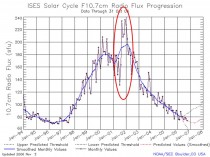
NOAA SEC solar flux (10.7cm) during cycle 23. Note the second solar max with extremely high flux from September 2001 to April 2002.
The winter of 2001/02 (figure above, enlarged here), when cycle 23 had a very strong high flux second maxima provided a perfect verification of Shindell and Labitzke and Van Loon’s (figure below, enlarged here) work.
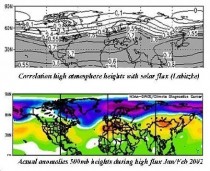
Labitzke correlated stratospheric heights with solar flux and actual height anomalies in the mid-troposphere during the high flux mode of the second solar max in early 2002.
The warming that took place with the high flux from September 2001 to April 2002 caused the northern winter polar vortex to shrink and the southern summer vortex to break into two centers for the first time ever observed. This disrupted the flow patterns and may have contributed to the brief summer breakup of the Larsen ice sheet (figures below enlarged here, here and here).
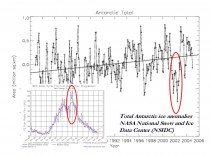
NASA NSIDC satellite derived Total Antarctic ice extent anomalies from 1979 to 2005. Note the dropoff with the Larsen ice sheet break-up in the summer of 2002 corresponding to major atmospheric changes during the high flux second solar max.
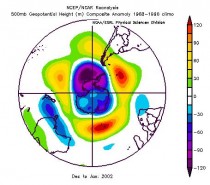
December 2001 to January 2002 500mb height anomalies for Southern Hemisphere. Note the ring of warming with the high flux induced UV ozone chemistry as a ring surrounding a shrunken polar vortex as seen in the Northern Hemisphere. Note how the vortex actually became a dipole with weakness in center. The changing winds and currents very likely contributed to the ice break of the Larsen ice sheet.

Larsen ice sheet break up late summer 2002 following strong solar flux break-up of southern polar vortex.
NASA reported on the use of the Shindell Ozone Chemistry Climate Model to explain the Maunder Minimum (Little Ice Age) (below, enlarged here).

Shindell ozone chemistry model forecast of the difference between the quiet solar period of the Maunder Minimum and the active late 18th century.
Their model showed when the sun was quiet in 1680, it was much colder than when it became active again one hundred years later. “During this period, very few sunspots appeared on the surface of the Sun, and the overall brightness of the Sun decreased slightly. Already in the midst of a colder-than-average period called the Little Ice Age, Europe and North America went into a deep freeze: alpine glaciers extended over valley farmland; sea ice crept south from the Arctic; and the famous canals in the Netherlands froze regularly - an event that is rare today.”
The UV is only one candidate solar related variance that may influence climate. Though the IPCC and alarmist scientists like to point to the small changes in the brightness as not being of significance and thus prove that the sun does not rule the climate, these other factors collectively likely make the sun the primary candidate for climate change - even the warming from 1977 to 1998 that is above and beyond the urbanization and land use change effects. It may be the sun works through the oceans as an intermediary or amplifying factor by influencing the multidecadal oscillations as Scafetta (2010) and others have suggested.
References:
Baldwin, M.P., Dunkerton, T.J.: (2004) The solar cycle and stratospheric-tropsospheric dynamical coupling, JAS 2004
Elsner, J. B., T. H. Jagger, and R. E. Hodges (2010), Daily tropical cyclone intensity response to solar ultraviolet radiation, Geophys. Res. Lett., 37, L09701, doi:10.1029/2010GL043091
Labitzke, K., The global signal of the 11-year sunspot cycle in the stratosphere: Differences between solar maxima and minima, Meteorol. Zeitschift, 10, 83-90, 2001.
Scafetta, N. “Empirical analysis of the solar contribution to global mean air surface temperature change” Journal of Atmospheric and Solar-Terrestrial Physics 71 1916-1923 (2009), doi:10.1016/j.jastp.2009.07.007
Scafetta, N., Empirical evidence for a celestial origin of the climate oscillations and its implications. Journal of Atmospheric and Solar-Terrestrial Physics (2010), doi:10.1016/j.jastp.2010.04.015
Shindell, D.T., D. Rind, N. Balachandran, J. Lean, and P. Lonergan, Solar cycle variability, ozone, and climate, Science, 284, 305-308, 1999a.
See more here.
ScienceDaily (June 9, 2010) - A new study of biological invasions in Europe found they were linked not so much to changes in climate or land cover, but to two dominant factors—more money and more people.
Wealth and population density, along with an increase in international trade and commerce, were the forces most strongly associated with invasive species that can disrupt ecosystems and cause severe ecological or agricultural damage, scientists said.
An international group of 26 researchers reported the new findings this week in Proceedings of the National Academy of Sciences.
Dealing with these issues will be “pivotal for policy makers and future management,” the researchers said, although no easy or inexpensive solutions exist, and many nations have been reluctant to take steps that might interfere with economic growth.
“Invasive species are a continuing and extensive ecological crisis, and we’re finding that human population and accumulated wealth are important drivers of this problem,” said Susan Shirley, a research assistant in the Department of Forest Ecosystems and Society at Oregon State University, and co-author on this study.
“Regional patterns of species invasions are complex, and there is still unexplained variation, likely due to local scale differences in several of the ecological factors,” Shirley said. “But invasive species are in large part an international trade issue, and this is an important problem we have not yet come to grips with. Next to population density, the closest correlation is to long-standing wealth, not more recent increases in income or economic activity.”
Human activities often related to trade, travel and transport, particularly in the past 50 years, have caused a surge in the number of introduced species, ranging from plants to fungi, insects, fish, birds, reptiles and mammals. Some are innocuous, but many displace native species and cause a range of ecosystem disruption. As a crossroads of international travel and trade, with both a high population and high income, Europe has experienced many invasive species.
The study concluded that other possible factors, such as climate, geography or land cover, were less significant than population density and wealth capital, and that those secondary causes may have been overestimated in the past.
The mechanisms of species invasion are often associated with international trade. Invasive species can hitch-hike on imported products, be brought to new regions as pets, be associated with contaminated food, or even introduced on purpose, as in the case of some ornamental plants or new crops.
In another recent study, Shirley and her colleagues researched bird introductions in Europe, and the findings supported this premise. Trade with Eastern Europe was severely disrupted for decades during the Cold War. By the end of that long period of international tension and restricted trade, Western Europe had experienced an increase in invasive bird species, but numbers in Eastern Europe actually declined.
In the new study, researchers were able to predict the number of alien species in Europe to a reasonably high degree simply by defining the level of wealth and the number of people.
“The overwhelming effect of human factors, wealth and demography, found for several taxonomic groups translates to human activities responsible for enhancing biological invasions,” researchers wrote in the study.
Solving this problem will not be easy, the study suggested.
Identifying the specific mechanisms of invasion is critical. Monitoring may need to be improved. Legislation to restrict or regulate certain imports will likely be needed, in addition to charging fees or tariffs that would help deal with invasive species when they occur. But the World Trade Organization and other international agreements “have no effective mechanisms” to address this concern, the authors said. And aside from good intentions, restrictions could be costly.
A major challenge, Shirley said, will be to understand the specific economic factors leading to introductions so they can be effectively addressed while minimizing negative impacts on international trade. These factors are likely to differ among species. For example, minimizing releases of vertebrate species might require additional regulation of the pet trade, while a focus on transport infrastructures such as roads may help control introductions of alien invertebrates.
“Nations do not have a good track record in forsaking future economic prosperity for environmental benefits,” the study concluded. “Only if the true determinants are identified will it be possible to predict and manage alien species invasions adequately without adverse effects on other economic sectors.”
See more here.
Vote on the motion to proceed was 47 to 53. Six Democrats and all 41 Republicans voted Yes.
Senator Rockefeller said that he was voting Yes because “I dont want EPA turning out the lights on America.” 53 of his Democratic disagreed. They have voted to give EPA the authority to turn out the lights on America. They must now take full responsibility for the economic consequences of EPA regulation of greenhouse gas emissions.
Washington, D.C. - Sen. James Inhofe (R-Okla.), Ranking Member of the Senate Committee on Environment and Public Works, today spoke on the Senate Floor in support of the motion to proceed to the Murkowski Resolution S.J. Res 26, disapproving a rule submitted by the EPA relating to the endangerment finding and the cause or contribute findings for greenhouse gases under section 202(a) of the Clean Air Act. The vote on the resolution is scheduled for this afternoon.
Statement by Senator Inhofe on Motion to Proceed to S.J. Res 26
Before I get into the history behind EPA’s endangerment finding and the Murkowski resolution, I want to address something we’ve heard from senators on the other side of the aisle. It is this: the Murkowski resolution is a Big Oil bailout that will allow oil companies such as BP to pollute the air.
Where to begin untangling the web of inaccuracies? Well, for one thing, I’m not sure how a Big Oil Bailout could be supported by:
- The American Association of Housing Services for the Aging
- Family Dairies USA
- The Farm Bureau
- The National Federation of Independent Business
- The Brick Industry Association
- The National Association of Manufacturers
- Associated Builders and Contractors
- The American Health Care Association
- The Arkansas Rice Federation
- The North Dakota Chamber of Commerce
- The Ohio Trucking Association
- Governors of 21 states
The list goes on and on. Do members on the other side of the aisle really believe that these groups have been duped, that what they are really supporting is nothing more than a sop to BP and Big Oil? This is simply insulting to the citizens all across the country who support the Murkowski resolution for one simple reason: it will stop the greatest bureaucratic intrusion into the lives of the American people, and it will stop a wave of crippling regulations that will send jobs to China and make consumers pay more for gasoline, food, and just about everything else.
Don’t be fooled by the empty rhetoric. Some unfortunately are exploiting the tragedy in the Gulf to advance a political agenda rooted in the belief that fossil fuels are a destructive nuisance that must be eradicated. And it sees an unrelenting bureaucracy and regulation as the means of realizing a future without them. But that belief, if carried out in the form of EPA’s impending greenhouse gas regulatory regime, will mean a radical change to our way of life-a change that will mean fewer jobs, fewer American businesses, higher taxes, energy rationing, and more control of people’s lives by a massive, unforgiving bureaucracy in Washington.
So understand that this resolution presents a fundamental challenge to that view-in the final analysis, it seeks to prevent EPA from realizing that radical agenda. As with health care, the Obama Administration, through the endangerment finding, is on the verge of taking over yet another facet of our economy. This resolution, if passed, will prevent that from happening.
The debate over the Murkowski resolution began even before the resolution was introduced in January. It really began 11 years ago, when the International Center for Technology Assessment, along with 18 other organizations, petitioned EPA to regulate greenhouse gases from cars and trucks under the Clean Air Act.
That petition went to then-EPA Administrator Carol Browner, but she never acted on it. And that was really no surprise, considering the US Senate, just two years earlier, voted 95 to 0 against the ruinous Kyoto Protocol.
So the decision on the petition carried over into the Bush Administration. In 2003, the Bush EPA denied the petition, which prompted a predictable raft of lawsuits by some states and environmental groups.
The case-called Massachusetts v. EPA-made its way to the Supreme Court, which in 2007 ruled that CO2 is a pollutant under the Clean Air Act, and that EPA must make a fundamental decision: either greenhouse gases from cars and trucks “endanger” public health and welfare or they don’t; or the science is so uncertain that it can’t make a decision either way.
The clock ran out on the Bush Administration, so this critical question of “endangerment” under the Clean Air Act carried over into the Obama Administration. In December last year, to no one’s surprise, the Obama EPA decreed that there is in fact endangerment.
This decision has far-reaching implications for how we use energy, how this country is governed, how businesses are regulated and controlled, and how we conduct our daily lives. Make no mistake: despite testimony to the contrary by senior officials, the Obama Administration was not forced by the Supreme Court to choose endangerment. As I noted, they had a choice, and they made the wrong choice. They chose to make an endangerment finding based on the flawed scientific conclusions of the UN’s Intergovernmental Panel on Climate Change, or IPCC.
By now everyone in this body is familiar with the work of the IPCC. This is the UN body that represents-at least according to some-the so-called “scientific consensus” that anthropogenic greenhouse gases are causing catastrophic climate change. But the Climategate scandal shattered the consensus once and for all. I won’t delve into great detail about this episode. In a report released earlier this year, the Minority Staff of the Senate EPW Committee found that Climategate scientists tried to manipulate key temperature datasets to predetermined conclusions about climate change.
Climategate scientists-again, these are no ordinary scientists; they are supposedly the best and brightest of the climate community-refused to share their work with those who disagreed with it; they undermined peer-review by blocking publication of legitimate work by skeptics; and they trashed the reputations of anyone who dared question their findings. An independent inquiry conducted by the UK’s Information Commissioner concluded that the scientists employed by the University of East Anglia, and who were at the center of the Climategate controversy, violated the UK’s Freedom of Information Act.
The Climategate scandal forced open the inner sanctums of the IPCC, and the public finally saw the political science the body had produced. I could go on for hours on the embarrassing litany of errors and mistakes, but I won’t; it’s not necessary. We don’t need to debate science on the floor today. There are varying opinions about what the science is telling us even in the Republican Conference. I accept that and respect my colleagues who differ with me.
What’s important today is focusing on where we agree. And we agree that EPA regulation of greenhouse gases under the Clean Air Act is a monumental mistake that will shackle the American economy with job-killing regulations and higher energy taxes.
Let me be blunt: EPA’s growing regulatory regime will lead to one of the greatest bureaucratic intrusions into the lives of the American people. Peter Glaser, an attorney with Troutman Sanders, and one of the foremost Clean Air Act attorneys in the country, said that EPA’s endangerment finding will lead to federal regulation of schools, hospitals, nursing homes, commercial buildings, churches, restaurants, hotels, malls, colleges and universities, food processing facilities, farms, sports arenas, soda manufacturers, bakers, brewers, wineries, and many others.
Imagine heading to church on Sunday to find the doors locked because it couldn’t afford to install Best Available Control Technology on its boiler. Of course EPA dismisses this and similar examples as nothing more than empty scare tactics. Besides, they contend, we exempted those facilities in our tailoring rule-that’s right, they’re out, so don’t worry.
EPA fails to mention that the Clean Air Act contains very specific emissions thresholds for regulated pollutants, and CO2 will be “subject to regulation” starting January 2, 2011. Under a program to maintain air quality, facilities that emit more than 250 tons per year of a given pollutant must obtain a Prevention of Significant Deterioration, or PSD, permit before they can build or make major modifications to existing facilities.
As I noted, 250 tons is a big number for traditional pollutants such as SO2 or NOx. But not for CO2. A large commercial building, for example, emits about 100,000 tons of CO2 a year. We’re talking about 6 million sources potentially subject to EPA regulation.
To get around this unmitigated administrative and economic disaster, EPA just changes the rules. That’s right: it merely decreed that regulations would apply only to facilities that emit more than 100,000 tons starting next year. That threshold would be tweaked over time and apply to sources at differing stages. But the point is clear: EPA can’t just change the unambiguous intent of Congress. 250 tons is 250 tons.
So don’t be fooled: EPA can’t wave away inconvenient provisions in the Clean Air Act with a regulatory wand. EPA’s so-called tailoring rule is now the focus of 14 lawsuits. It seems almost certain that the DC Circuit will overturn it and force EPA to grapple with the regulatory nightmare of its own creation.
Again, I warn those who take comfort in the exemptions provided in the tailoring rule. Those exemptions will be short-lived, for the simple reason that the courts will strike it down. And even if they don’t, EPA has committed to eventually lower the thresholds to capture small sources. So one way or another, if you think you’re out, it’s likely at some point you’ll be in.
What are the economic impacts? We’re just getting a handle on them. According to EPA’s own documents, PSD permits cost an average of $125,120 and impose a burden of 866 hours on the applicant. In addition, the nation largest employers, such as refineries, electric utilities and industrial manufacturing facilities, will be forced to install (currently undefined) best available control technology (BACT) at their plants to reduce CO2.
This requirement is creating uncertainty, and employers are reluctant to hire and expand, until this mess is sorted out. And don’t forget about the prospect of lawsuits. I’ll bet the farm environmental groups fan out across the country and sue facilities they don’t like. None of this can be good for those out of work and looking for a job.
The tailoring rule is one reason some may choose to vote against the Murkowski resolution. There are other stated reasons for opposition that I want to address, because I believe they are pretexts that can’t justify opposition to this resolution.
I mentioned the science supporting the endangerment finding-some will argue today that overturning the finding through the Congressional Review Act amounts to an indictment of the IPCC- backed scientific consensus. But let’s understand what’s at issue here: we are stopping EPA from undertaking the most unprecedented bureaucratic intrusion into the lives of the American people.
Frankly, one’s view of the science here is irrelevant. As Marlo Lewis of the Competitive Enterprise Institute has noted, Congress is removing the legal force and effect of the endangerment finding. The resolution says nothing about the reasoning EPA employed, or the substance of that reasoning, to reach the scientific conclusions supporting the endangerment finding. So opposing the Murkowski resolution because you oppose overturning science is not a legitimate basis of opposition.
Another excuse for voting against the resolution is that overturning endangerment will mean removing the authority of the National Highway Traffic Safety Administration (NHTSA) to set Corporate Average Fuel Economy Standards (CAFE). More specifically, some argue, it would undo the historic auto deal reached last May between the auto companies, the White House, EPA, DOT, and California. The only problem with this argument is that it’s wrong.
Just ask the Obama Administration. “As a strictly legal matter,” according to a February 19 letter by Kevin Vincent, NHTSA’s general counsel, “the Murkowski resolution does not directly impact NHTSA’s statutory authority to set fuel economy standards under the Energy Policy and Conservation Act (EPCA), as amended by the Energy Independence and Security Act of 2007(EISA).”
So we’re hearing that this resolution will revoke the new CAFE standards and increase the amount of oil we consume. It’s patently false to assert NHTSA can’t continue to work on, and then implement, the CAFE standards Congress passed in 2007. That’s what it’s doing now, and will continue to do regardless of what happens here today.
I hope that what happens here is that we vote to overturn EPA’s endangerment finding. If we don’t, that doesn’t mean we stop here. We will continue to pursue all of our options to stop, delay, and obstruct EPA from overtaking our nation’s energy sector and directing and controlling the minutiae of our daily lives.
By Bob Ferguson, SPPI
Below are some recent papers posted at SPPI , both originals and reprints. The topics/titles of the papers can pretty much be gleaned from the urls.
As usual, they are a blend of popular and more technical papers. Of particular note are those dealing with increasing alarm campaigns on species and ocean acidification —numbers 6, 7, 10, 13, 15. Also, particularly illuminating is Ambler’s paper on IPCC Chair Pachauri—number 14. The Monthly CO2 Report compiled by Monckton is a must read - number 11. Finally, Nic Scafetta’s in press paper - number 2 - should prove a provocative read concerning evidence for the celestial origins of climate oscillations.
2. Climate Oscillation Evidence
3. Musings on the Hurricane Season
5. Cuccinelli vs 810 Academics
7. Quantifying the Effects of Ocean Acidification
10. EPA Role in Protecting Ocean
12. Viscount Congress Testimony
14. No Fossil Fool
15. Answers to Fishers Testimony
Be sure to look over some of our postings at the SPPI blog.
-----------------
UVA’s Defense of Michael Mann: Back Off, He’s a Scientist!
By Chris Horner, Pajama’s Media
The University of Virginia has filed a petition to set aside civil investigative demands (CIDs) issued to it by the Commonwealth’s attorney general, Ken Cuccinelli.
CIDs are akin to grand jury subpoenas. Cuccinelli’s inquiry was prompted by public disclosure - via the ClimateGate leaks - of the highly questionable academic practices of former UVA assistant professor Michael Mann. The disclosure of Mann’s activities involved the apparent leaking of emails, computer code, and annotations to the code, all of which were subject to and being pursued under the United Kingdom’s Freedom of Information Act.
Arguing against the request that they produce records related to Mann’s use of taxpayer-funded grant money, UVA reeled off a litany of rationales - mostly general and repetitive - regarding why they do not need to comply.
UVA’s reason #8 - out of nine, its placement inherently recognizing its weakness - headlines the opening rhetoric of its petition and is being used by the school as a public relations hook:
Enforcing the CIDs will interfere with recognized First Amendment principles and important public policies protecting the academic freedom of institutions of higher learning from government intrusion into research and scientific inquiry.
You know, like Stanford University was immune from inquiry into misusing taxpayer funds earmarked for scientific research during the most notorious pre-ClimateGate academic scandal. Oddly, Time magazine’s coverage at the time was not concerned about “academic freedom” being imperiled: “Scandal in the Laboratories: Inquiries at Stanford turn a harsh light on how university research is funded.”
Gasp! “Inquiries”?
Stanford was no more exempt from laws, oversight, or conditions on how it spends taxpayer funds than are Mann or UVA. As a result, Stanford president and current Mann defender Donald Kennedy soon found himself out the door.
UVA’s current tack is simply to hope for public - and possibly judicial - sympathy to result from the escalating pressure campaign from what I call Big Science. Big Science is outraged that its constituents should be subject to laws applied to the little people and is desperate to expansively rewrite the concept of “academic freedom” as license to be free from compliance with those laws.
While Mann’s defenders were quick to unholster Hollywood-style shrieks of “McCarthyism,” the more appropriate analogy seems to be Tinseltown’s current victimization/canonization of Roman Polanski. He’s an artist! These laws you speak of, well, they exist, and surely have some merit, just...didn’t you see Chinatown?
The “I’m a scientist!” defense is the academy at its most cartoonish.
Doubling down on this unseemliness, the UVA then invokes Thomas Jefferson(!) while making the argument that laws are for others, and not preferred, protected classes of people. In its petition, UVA cites a 1950s Supreme Court opinion - Sweezy v. New Hampshire - for the following dicta:
To impose any strait jacket upon the intellectual leaders in our colleges and universities would imperil the future of our Nation… Teachers and students must always remain free to inquire, to study and to evaluate…
No, the ellipses do not suppress “...and to commit fraud, or otherwise disregard the laws of the land.” And no fancy Latin canon of construction - noscitur a sociis, ejusdem generis, in pari materia… take your pick, they all fail - informs a conclusion that the UVA argument is what the Sweezy Court intended.
But what of the two prongs of that risible “any strait jacket” business the school hangs its hat upon? Of two plausible readings of this, the less plausible is that “any” indicates the Supreme Court deemed academics, of “any” sort no less, to be beyond prosecution - so long as the perpetrator claims a research purpose (and with nothing less than the fate of the nation at risk were things otherwise! Sigh.)
Alternately, the university begs the question: where do standards applied to the rest of us end and a “strait jacket” begin? Or, where does protection of intellectual discourse - not actually at issue here, despite UVA hand-waving to the contrary - end and selective immunity from the laws of the land begin? These are now questions for the Virginia courts.
Sweezy is an Eisenhower-era opinion, written shortly before Ikeís farewell address. The address is famous for warning of a “military-industrial complex,” but also for warning: Be alert to the equal and opposite danger ["opposite" of stifling academic freedom] that public policy could itself become the captive of a scientific-technological elite.
Sadly, this has come to pass, with the University of Virginia among its most zealous defenders.
UVA’s invocation of the wholly inapplicable Sweezy illustrates the barrenness of its legal cupboard, and no distraction will change that the precedent it cites is wholly irrelevant to Mr. Cuccinelli’s inquiry into possible civil fraud. The university expends great effort to make the issue other than what it plainly is.
“Academic freedom” has of course never meant selective sanctioning of unlawful behavior. And the attorney general is not, as the university claims to the court, “engag[ing] in scientific debate.” That the university cannot or will not see this only further makes the case that it is not capable of self-investigation.
Which raises a final point. In its petition, UVA proves far too much. For example, it references two other inquiries into aspects of ClimateGate. Where, pray tell, was the outrage by Big Science or academia over these two?
The answer is that the pretense of self-policing by the University of East Anglia and by Mann’s current home, Penn State, were both exercises in wagon-circling. When they were announced, Big Science remained mum because this was transparently so, as evidenced by their stacking panels with sympathetic parties highly unlikely to conclude otherwise than they did.
About these, UVA rather disingenuously claims “the subsequent investigations have not found any fraudulent conduct.’ Of course they didn’t - neither inquired into fraud! Instead, both narrowly tailored their reviews to less treacherous waters.
By this mischaracterization to the court, UVA stretches the truth while doing its credibility no good. Which nicely summarizes the entire Mann affair. See post and comments here.
Christopher Horner is a senior fellow at the Competitive Enterprise Institute, and author of the recently-published Power Grab: How Obama’s Green Policies Will Steal Your Freedom and Bankrupt America.
ICECAP NOTE: “...whenever the people are well-informed, they can be trusted with their own government; that, whenever things get so far wrong as to attract their notice, they may be relied on to set them right.” Thomas Jefferson (as cited in Padover, 1939, p. 88). Here Jefferson is suggesting the state allow the people to become well informed by allowing for Cuccinelli to proceed witrh the inquiry so as to set the matter right.
By Ben Eisen
Gore-inspired strategy of hiding and name-calling continues to backfire.
The Heartland Institute, a Chicago-based think tank, recently hosted a conference on climate change. Heartland can be fairly described as sceptical of the idea that global warming is primarily man-made, or that if occurring it represents a serious problem. However, the organizers were keen to include representatives of all sides of the debate. Invitations were therefore extended to global warming sceptics such as Harvard’s Willie Soon and MIT’s Richard Lindzen - but also prominent scientific supporters of the International Panel on Climate Change (IPCC) view that manmade global warming is a serious threat.
Unfortunately, the conference did not work out as planned. Out of the dozens of supporters of the IPCC’s conclusions that were invited, only two were willing to attend. The result was an informative and fascinating but unbalanced conference. One sceptic after another took the stage and showed how their research casts doubt on catastrophic predictions, with few defenders of the IPCC position present to provide a critique. The organizer of the program was disappointed, and apologized to the audience for the fact that more supporters of the IPCC view had declined his invitation.
The conference was still useful, in that it gave the lie to the claim that the “debate is over” surrounding the science of global warming. The conference featured a world-famous astrophysicist explaining his opinion that solar activity has caused recent increases in temperature. It also included an MIT atmospheric physicist who argued the sensitivity of temperature to atmospheric greenhouse gas concentrations is badly overestimated by the IPCC. These were just two of many impressive presentations. One can’t listen with an open mind to this parade of experts who dispute the IPCC’s conclusions and still take seriously the claims that the “debate is over.”
And yet, while the presentations were informative, it was impossible to accurately assess the strength of the evidence due to the absence of competing points of view. The strength of arguments in technical areas are best evaluated under pressure. It is important to see experts who disagree analyze one another’s work, and clearly state why they remain unconvinced by the conclusions. With no similarly qualified experts willing to debate with Soon, Lindzen, and the other sceptical experts, it was impossible to assess which side has the strongest arguments.
So why wouldn’t the defenders of the majority opinion that manmade global warming is a threat show up to debate the dissenters? Perhaps some feared they would be treated badly or unfairly - if so, these fears were unfounded. The two supporters of the IPCC view who did attend were treated warmly, and thanked repeatedly for creating a small measure of balance.
It seems likely the refusal of most IPCC supporters to attend was the result of a conscious decision taken some time ago not to engage people who are sneeringly referred to as “deniers.” Because it is less likely that political action will be taken as long as it is known there is a lively scientific debate, prominent environmental activists have argued that “deniers” should simply be ignored and marginalized, regardless of their credentials or the quality of their work.
The clearest example is the refusal of Al Gore - the man who popularized the most catastrophic theories about global warming - to even debate the topic. Imagine if the leading proponents of tax cuts refused to debate Keynesian advocates because the “economics are settled.” They’d be laughed out of the public sphere - and deservedly so.
The strategy of refusing to engage dissenters has been unsuccessful. Public perception of the issue is shifting in the direction of the sceptics. In December 2009, just 52 per cent of Canadians said that they are convinced that global warming is a man-made phenomenon- down from a peak in the mid-60s. In the United States, belief in man-made warming dropped from 51 per cent to 46 per cent in the second half of 2009. Gore’s strategy of disengagement has apparently backfired.
By refusing to confront their critics head-on, the majority of climate scientists give the appearance they are afraid of debate. That leads many to conclude their case is weak. Proponents of the IPCC should abandon the strategy of marginalizing dissenters and calling them names. Instead, if they really believe the facts are on their side, they need to actually engage those who think otherwise. Until then, public skepticism will continue to grow towards a political and scientific community that consistently hides from its brightest, most articulate critics.
---------------
Ben Eisen is a Policy Analyst with the Frontier Centre for Public Policy. His undergraduate degree is from the University of Toronto where he specialized in history and political science. He also holds a Masters Degree in Public Policy from the University of Toronto’s School of Public Policy and Governance. Ben completed a public policy internship with the federal government, and he worked as a researcher for the CBC. Ben’s policy columns have been published in the National Post, the Winnipeg Free Press, the Calgary Herald, The Gazette and the Toronto Sun.
By Joseph D’Aleo
Both Drs. Gray and Klotzbach and NOAA and many in private industry are predicting a very active Atlantic tropical season. Since 1995, the Atlantic has become twice as active on average as the prior 25 years, similar to the period from 1930s to 1960s. This is due to a shift to the “warm” mode of the multi-decadal scale oscillation in the Atlantic Ocean.
Most of the storms making landfall since 1995 have impacted the Mid-Atlantic region, Florida and the Gulf of Mexico However, though not yet realized, history tells us that the risk has also increased for more populated areas to the north (Long Island and New England) (below, enlarged here and here).
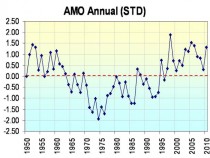
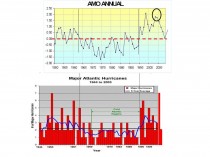
Note the increase in the number of stronger storms after the flip back to the warm mode in 1995 (below, enlarged here and here).
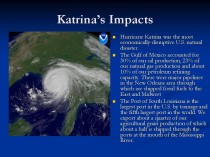

Bill Gray has shown the number of land falling storms along the southeast coast increases in the warm mode (above). The same can be said for the Atlantic coast in general as shown below (enlarged here).
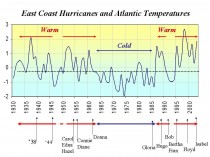
Those that survive often recurve out to sea or escape the shear by taking a more southern route through the Caribbean to the Gulf, where most make landfall.
The landfall depends on the strength and position of the Bermuda High in the Atlantic. A tropical system will tend to turn north at first opportunity including a weakness in the Bermuda high. The stronger and farther west the high extends, the further west the storm moves before turning or landfall (enlarged here).
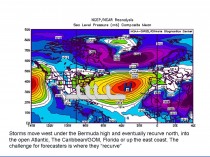
El Ninos tend to produce fewer storms by increasing the shear in the Atlantic, fed by increased Pacific tropical activity (enlarged here).

Those that survive often recurve out to sea or escape the shear by taking a more southern route through the Caribbean to the Gulf, where most make landfall (enlarged here).
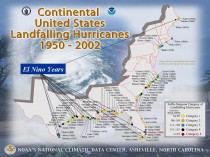
La Ninas on the other hand show less shear, more storms and more landfalls. Weakness of pressure along the east coast favors more landfalls(enlarged here).
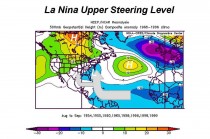
Those that survive often recurve out to sea or escape the shear by taking a more southern route through the Caribbean to the Gulf, where most make landfall (enlarged here).
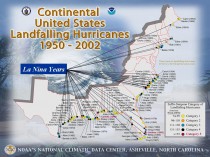
The La Nina landfalls are in the Gulf, Southeast Coast and the Northeast/New England.
THE EFFECT OF THE PACIFIC DECADAL OSCILLATION
The PDO affects the relative frequency of the El Nino and La Nina. We turned to the colder mode of the PDO in the late 1990s, which tends to mean more La Ninas like the last cold mode 1947 to 1977(enlarged here).

The area of the east coast north of Cape Hatteras risk is greatest during La Nina years when the PDO is negative and the Atlantic is warm (this summer!) (enlarged here).
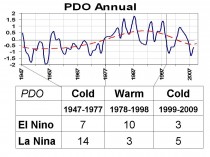
See how New England landfalls vary with the PDO (enlarged here).
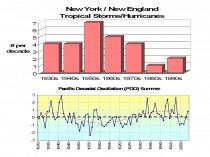
La Nina Years Occurring with Warm Atlantic Summers
* 1938 Hurricane of ‘38 (CAT 5) New York and New England
* 1950 Hurricane Easy (CAT 3) Florida, Hurricane King (CAT 3) Florida
* 1954 Hurricane Carol (CAT 3) New York and New England, Hurricane Edna (CAT 3) New England, Hurricane Hazel (CAT 4) Mid-Atlantic and northeast
* 1955 Hurricane Connie (CAT 3) NC, VA, NY, New England Flooding, Hurricane Diane (Cat 1) NC, New England Flooding
* 1960 Hurricane Donna (CAT 4) FL, (CAT 3) NY, New England
* 1989 Hurricane Hugo (CAT 4) SC
* 1996 Hurricane Bertha (CAT 2) NC, Hurricane Fran (CAT 3) NC
* 1998 Hurricane Bonnie (CAT 2) NC
* 1999 Hurricane Floyd (CAT 2/3) NC
15 landfalling storms in the 9 years!!!!! 11 major hurricanes. 9 affected northeast
HOW THE TROPICAL ATLANTIC WARMED
Ironically this was the result of the record negative AO and very cold Northern Hemisphere winter in the southern US, Europe, Russia, China. A record negative AO suppressed jet streams and subtropical highs in both oceans (enlarged here).
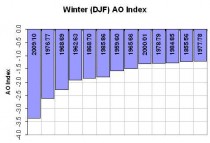
Lower wind speeds and reduced cloudiness due to subsidence in the deep subtropics led to warm water near the surface (bottom right) (enlarged here).
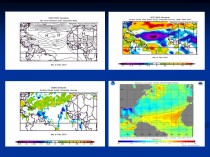
The very latest Atlantic sea surface temperature analysis from the Hurricane Center showing the warm water that will help feed the activity (enlarged here).
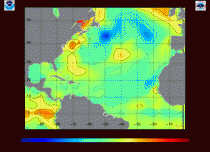
All this raises great concern about landfalling hurricane and the threat of one or more systems affecting the northeast that since 1995 has seen only remnants of storms that made landfall south. See the fill PDF with enlarged graphics here.
Also the first tropical storm of the season from the eastern Pacific hit Central America this weekend with deadly results.
By Paul Driessen
“Scientific debates should be played out in the academic arena,’ insists University of Virginia environmental sciences professor David Carr. “If Michael Mann’s conclusions are unsupported by his data, his scientific critics will eventually demonstrate this.” (ICECAP NOTE: Already done David)
Carr and 809 other Virginia scientists and academics signed a petition launched by the activist Union of Concerned Scientists, protesting Commonwealth Attorney General Ken Cuccinelli’s investigation of former University of Virginia professor Michael Mann. The American Association of University Professors likewise opposes Cuccinelli, who is seeking documents from UVA, to determine whether there are grounds to prosecute Mann for violating the Fraud Against Taxpayers Act, by presenting false or misleading information in support of applications for state-funded research.
Carr claims Cuccinelli is attempting to “drown out” scientific debate.” Others have accused the AG of conducting a “witch hunt,” engaging in “McCarthyite” tactics, and “restricting academic freedom.”
It’s time to clear a few things up.
Mann is the former UVA professor, whose “hockey stick” temperature chart was used to promote claims that “sudden” and “unprecedented” manmade global warming “threatens” human civilization and Earth itself. The hockey stick was first broken by climatologists Willie Soon and Sallie Baliunas, who demonstrated that a Medieval Warm Period and Little Ice Age were clearly reflected in historic data across the globe, but redacted by Mann. Analysts Steve McIntyre and Ross McKitrick later showed that Mann’s computer program generated hockey-stick patterns regardless of what numbers were fed into it - even random telephone numbers; that explained why the global warming and cooling of the last millennium magically disappeared in Mann’s “temperature reconstruction.”
The Climategate emails revealed another deliberate “trick” that Mann used to generate a late twentieth-century temperature jump: he replaced tree ring data with thermometer measurements at the point in his timeline when the tree data no longer fit his climate disaster thesis. During his UVA tenure, he employed other sly statistical tricks to generate a purported, and truly unprecedented, CO2-driven warming of 2-4.5 degrees F per decade (1-2.5 degrees C). That extrapolates to as much as 45 degrees F per century!
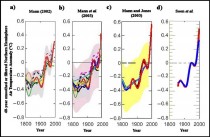
Not surprisingly, he refused to share his data, computer codes and methodologies with skeptical scientists. Perhaps worse, Climategate emails indicate that Mann and others conspired to co-opt and corrupt the very scientific process that Carr asserts will ultimately condemn or vindicate them.
This behavior certainly gives Cuccinelli “probable cause” for launching an investigation. As the AG notes, “The same legal standards for fraud apply to the academic setting that apply elsewhere. The same rule of law, the same objective fact-finding process, will take place.” Some witch hunt.
There is simply no room in science, academia or public policy for manipulation, falsification or fraud. Academic freedom does not confer a right to engage in such practices, and both attorneys general and research institutions have a duty to root them out, especially in the case of climate change research.
Work by Mann and other alarmist scientists is not merely some theoretical exercise that can be permitted to “play itself out” over many years, if and when the “academic arena” gets around to it. These assertions of climate crisis are being used right now by Congress, states, courts and the Environmental Protection Agency to justify draconian restrictions on energy use and greenhouse emissions. They would shackle our freedoms and civil rights and hammer our jobs, economy, health, welfare and living standards.
If the science is wrong - or far worse, if it is manipulated, fabricated, fraudulent and covered up - then grave damage will be done to our nation, liberties and families, before the truth gets its boots on.
As to “scientific debate” over global warming, there has been virtually none in the academic arena. The science is viewed as “settled,” debate has been squelched, and those who seek to initiate debate are attacked, vilified, harassed and shipped off to academic Siberia.
Dr. Patrick Michaels, another former UVA climate researcher, was fired as Virginia State Climatologist by then-Governor Tim Kaine for raising inconvenient questions and facts on climate science. When Greenpeace demanded access to Michaels’ emails, UVA promptly acceded - before contesting AG Cuccinelli’s request for Mann’s.
The 810 protesters and their UCS and AAUP consorts were silent. Their principles and objections do not seem to apply to shrill activist groups infringing on the academic and scientific freedom of “politically incorrect” researchers, even when there is no suggestion of dishonesty. Other “skeptical” climate researchers have met with similar fates. The pungent scent of hypocrisy fills the air.
No surprise there. The massive US government climate change research gravy train alone totaled some $9 billion in grants during 2009, courtesy of hardworking taxpayers. IPCC, EU & Company climate grants - plus billions more for renewable energy research - fatten the larder still further. Now that money, prestige and power are threatened.
Climategate and other revelations about the lack of evidence for the “manmade climate disaster” thesis have sent belief in AlGorean gloom and doom plummeting. Global warming consistently comes in dead last on any list of environmental concerns. Three-fourths of Americans are unwilling to spend more than $100 a year to prevent climate change. China, India and other developing nations properly refuse to sign a carbon-cutting economic suicide pact.
The public is rightly concerned that in-house investigations by Penn State University (Mann’s current institution), East Anglia University (home of Phil Jones and the Climategate emails) and the IPCC have the patina of a Tom Sawyer whitewash. Independent investigations like Cuccinelli’s are absolutely essential, to ferret out fraud and misconduct - which may be rare but must be dealt with when it happens.
Dr. Andrew Wakefield falsified studies to create a connection between autism and trace mercury in vaccines against measles, mumps and rubella. Britain stripped him of his right to practice medicine. But meanwhile, a lingering stench remains over double standards; World Wildlife Fund press releases and rank speculation masquerading as peer-reviewed science; computer models enshrined as “proof” of looming climate disasters; and billions being squandered on research purporting to link global warming to nearly every malady and phenomenon known to man.
We the taxpayers are paying for this work. We the people will pay the price - in soaring energy bills, fewer jobs, lower living standards and lost freedoms - for draconian energy and emission laws enacted in the name of saving the planet.
We have a right to insist that the research be honest and aboveboard. That the work products stay in the public domain, available for scrutiny. That researchers share their data, computer codes and analytical methodologies, and engage in robust debate with skeptics and critics. That those who violate these fundamental precepts forfeit their access to future grants. And that our tax dollars no longer fund bogus acne-and-climate-change studies and alarmist propaganda. (Talk about budget cutting opportunities!)
It’s certainly understandable that scientists, academics, eco-activists and the AAUP and UVA would line up behind Mann and against Cuccinelli. There’s a lot of power, prestige and cash on the line. But it is essential that the attorney general and law-abiding citizens insist on transparency, integrity, credibility and accountability in the climate change arena.
We should support what Ken Cuccinelli is doing - and demand that Eric Holder and other state AGs take similar action. Read more of this excellent piece by Paul Driessen here.
ICECAP Note: The irony is the same things Carr accuses Cuccinelli of are exactly what Mann, the Universities, the Union of Concerned (Corrupt?) Scientists and the 810 academics have been practicing for years - “drowning out scientific debate”, conducting a “witch hunt” and purging scientists that might endanger the Universities getting in on the huge grant bonanza, engaging in “McCarthyite” tactics, and “restricting academic freedom.” I could tell you many shocking stories from around the country of how true academic freedom is now being repressed by these same scientists. Cuccinelli should be allowed to proceed and let the chips fall where they may. In discovery, the truth will come out, which is why the academics are so vocal and running scared. Best of luck to Cuccinelli. The good people of Virginia need to know the truth. Let Virginia be to this issue what Arizona has been to the immigration issue. Forcing a light to shine on a too long ignored issue. Doing nothing now is no answer. A corrupt system will never clean its own house.
Dr Charles Battig says it well:
In “Fighting back?”, the response of UVa to the legal request by A.G. Ken Cuccinelli for documents of ex-UVa climatologist M. Mann are couched in terms of “defense of academic freedom.” Rather than open up the halls of academic freedom to the light of day, UVa is presumably spending taxpayer monies to hire an international law firm to seek other options. Is there something to hide in Mann’s documents? What aspect of academic freedom is being threatened? Were the documents of ex-UVa Prof. Pat Michaels released to Greenpeace after similar deliberation? Public funding comes with legal strings attached. The public is entitled to know that assumed academic integrity is being upheld.
The A.G. has stated he is not investigating the scientific merit of Mann’s work. He need not. Others, including Canadians Steve McIntyre and Ross McKitrick, and the 2006 U.S. Senatorial (Wegman) investigation have done so. In 2001, Mann effectively re-wrote global temperature history with his “hockey stick” graphic portal of an unperturbed temperature record until the modern industrial age showed a rapid upswing. His flat-line portion of the plot erased the warmer medieval and the cooler little ice age periods, both documented in written and pictorial history. The Canadian researchers eventually demonstrated that the hockey stick graph was an artifact of the data processing algorithms used by Mann. An input of random numbers fed into the same process also produced hockey stick graphs. The Wegman commission noted that Mann considered his data his intellectual property, choose to withhold it from his peers, and thereby from peer review.
The UVa response echoes that of the cabal of celebrity climatologists involved in the 2009 “climategate” scandal. U.K. climatologist Phil Jones actively eluded Freedom of Information Requests for his data. “Hide the decline” is now linked to M. Mann. Penn State continues to investigate Mann. Academic freedom does not obviate academic accountability.
CBC News
The Nunavut government does not think the polar bear should be classified as a species of special concern under the federal Species at Risk Act, says territorial Environment Minister Daniel Shewchuk.
Shewchuk said there is no clear evidence to support assigning that status to the polar bear despite recommendations to the contrary by Environment Canada and a federal scientific panel.
“We live in polar bear country,” Shewchuk told reporters in Iqaluit on Friday afternoon. “We understand the polar bears, and we do actually think our polar bear population is very very healthy, with the exception of a couple of populations that we are taking action on.”
The polar bear was most recently designated a species of special concern in 2002. “Of special concern” is the least serious “at risk” designation - one level below “threatened” and two levels below “endangered.”
Currently, the special-concern designation has been suspended while the government reviews the polar bear’s status and decides whether to renew the classification or change it.
An arm’s length scientific panel, the Committee on the Status of Endangered Wildlife in Canada (COSEWIC), reviewed the polar bear’s status in 2008 and recommended that it remain in the special-concern category.
Change of position
Speaking to reporters Friday in Iqaluit, Nunavut Environment Minister Daniel Shewchuk said his government has an ‘excellent track record’ on collaborative wildlife management. (CBC)The recommendation has initiated a long process of hearings and consultations, including a round of hearings in Nunavut in April.
Environment Canada is expected to decide in a couple of months whether to renew the special concern status.
Shewchuk said while the Nunavut government originally agreed with the special-concern listing, it changed its position after consulting with Inuit hunters and others on a recent community tour.
“Through direct consultation, they are unanimous in their belief that polar bears have not declined,” Shewchuk said.
Scientists on the committee have argued that although Canada’s polar bear population has improved over the last 50 years, the future of the species could be threatened by climate change and receding sea ice.
“Certainly, we recognize that the Arctic may experience substantial impacts from climate change,” Shewchuk said. “But listing polar bears now, based on predicted but unknown future impacts, is not reasonable.
“Based on hunter observations, polar bears are presently still healthy and abundant across Nunavut ó and for that reason, not a species of special concern.”

At-risk designation requires management plan
Being listed as a species of special concern means polar bears must be protected by a management plan that would address the habitat and survival of the species.
But Shewchuk said the Nunavut government already has an “excellent track record” in terms of collaborative wildlife management, using a combination of the best scientific data and Inuit traditional knowledge.
He said appropriate steps are already being taken to conserve two polar bear subpopulations - in western Hudson Bay and Baffin Bay - that have been of most concern to federal authorities.
Those subpopulations have been of concern to scientists who said their numbers are declining. Inuit in those areas have disputed the scientific claims, saying they have seen more bears.
Shewchuk said his new decision has already been sent to federal Environment Minister Jim Prentice.
“I’m aware that I will be under tremendous pressure externally for no longer supporting the special-concern proposal,” he said.
“However, I’m being responsive and listening to Nunavummiut, especially hunters and elders, who have lived all their lives in the North, who have extensive and professional knowledge of the environment and our wildlife in Nunavut,” he said. Read more here.




